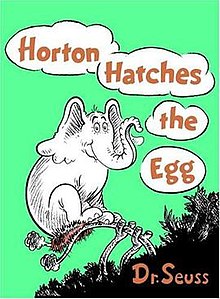Horton Hatches the Egg: Difference between revisions
Wile e2005 (talk | contribs) →Warner film: Found out about the storyboard thing in "Of Mice and Magic" |
No edit summary |
||
| Line 2: | Line 2: | ||
'''''Horton Hatches the Egg''''' is a book by [[Dr. Seuss]], first published in [[1940]]. |
'''''Horton Hatches the Egg''''' is a book by [[Dr. Seuss]], first published in [[1940]]. |
||
Horton would make another appearance in a Dr. Seuss book, ''[[Horton Hears |
Horton would make another appearance in a Dr. Seuss book, ''[[Horton Hears a Who!]]'', fourteen years later. Here, he would exhibit the same traits and endure similar ridicule. |
||
The book concerns Horton (an elephant) convinced by an irresponsible bird named Mayzie into sitting on her egg while she takes a break--which proves to last for months. Of course, the absurd sight of an elephant sitting atop a tree makes quite a scene. |
The book concerns Horton (an elephant) convinced by an irresponsible bird named Mayzie into sitting on her egg while she takes a break--which proves to last for months. Of course, the absurd sight of an elephant sitting atop a tree makes quite a scene. |
||
Revision as of 19:54, 7 February 2008

Horton Hatches the Egg is a book by Dr. Seuss, first published in 1940.
Horton would make another appearance in a Dr. Seuss book, Horton Hears a Who!, fourteen years later. Here, he would exhibit the same traits and endure similar ridicule.
The book concerns Horton (an elephant) convinced by an irresponsible bird named Mayzie into sitting on her egg while she takes a break--which proves to last for months. Of course, the absurd sight of an elephant sitting atop a tree makes quite a scene.
Horton is laughed at by his jungle friends, exposed to the elements, captured by hunters, forced to endure a terrible sea voyage, and finally placed in a traveling circus. All through the ordeal Horton repeats this refrain:
- I meant what I said, and I said what I meant:
- An elephant's faithful one hundred percent.
Mayzie finds Horton at the circus and recognizes him. Her egg lets out a loud noise and begins to hatch. Mayzie demands the egg back, but as Horton is about to give her the egg back, it hatches and the creature that emerges is a cross between Horton and Mayzie ("An ELEPHANT-BIRD"). No judgment is made as to who the parent should be, but Mayzie is seen sitting off to the side as if she knows she has lost and the baby is shown happily flying to Horton. The story ends with Horton and the baby being returned to the jungle "happy, one-hundred percent." The moral of the story is "be responsible, even when it's difficult." This moral is established in several ways. First, Mayzie's demonstrated irresponsibility in leaving her egg for someone else to watch leads to her losing the implied benefit of her egg- a baby Mayzie. Second, Horton's demonstrated responsibility in keeping his promise to Mayzie by staying with the egg, even when it's hard to do so, gives him the benefit of a baby Horton hatching from the egg. Finally, the elephant's ability to stay true and steadfast despite all manner of disasters carries a traditional spiritual message: he is faithful, not only to his external obligations, but to his inner self as well.
- Alternate interpretation: It is an allegory for adoption and the devotion of parents who raise the children who they may not have given birth to, but have given their love and devotion to, none the less.
Warner film
Horton Hatches the Egg was adapted by Warner Brothers in 1942, directed by Bob Clampett. In producing the cartoon, the Warner Bros. Animation crew did not use a storyboard, but sketched and wrote additional ideas to the cartoon in Clampett's copy of the book. A couple of interesting gags appeared in the cartoon that were not in the original. A fish caricature of Peter Lorre says, upon seeing Horton pass by in a ship, "Well, Now I've seen everything" and promptly shoots himself in the head (a grisly staple of the "Termite Terrace" gag writers that has been edited out on such channels as Cartoon Network [not counting The Bob Clampett Show], the former WB! channel, TBS, and TNT [it should also be of note that TNT aired a cartoon special called "In Search of Dr. Seuss" that had this cartoon short in it with new dialogged dubbed over the original track]. On a special feature in Looney Tunes Golden Collection Volume 2, there is a clip of the fish saying his last words, then it cuts to a montage featuring various clips of Bob Clampett cartoons.). Mayzie also does a breathy Katharine Hepburn impersonation ("raaaaaaaa-hlly I do") at several points. The cheerful elephant (along with his son, at the end) sing a popular nonsense tune of that era, "The Hut-Sut Song" by Horace Heidt.
Soyuzmultfilm film
In 1966, Soyuzmultfilm released an 18-minute Russian language film called I Am Waiting for a Nestling based on the story. [1] It was directed by Nikolai Serebryakov. It won the Silver Medal for Best Children's Film at Tours, 1967.
Trivia
- This story is alluded to in an episode of The Wubbulous World of Dr. Seuss episode "The Song of the Zubble-Wump," where Horton mentions that he's had experience in hatching eggs.
- This book along with Horton Hears a Who provide the thrust of the plot for the Broadway musical Seussical.
